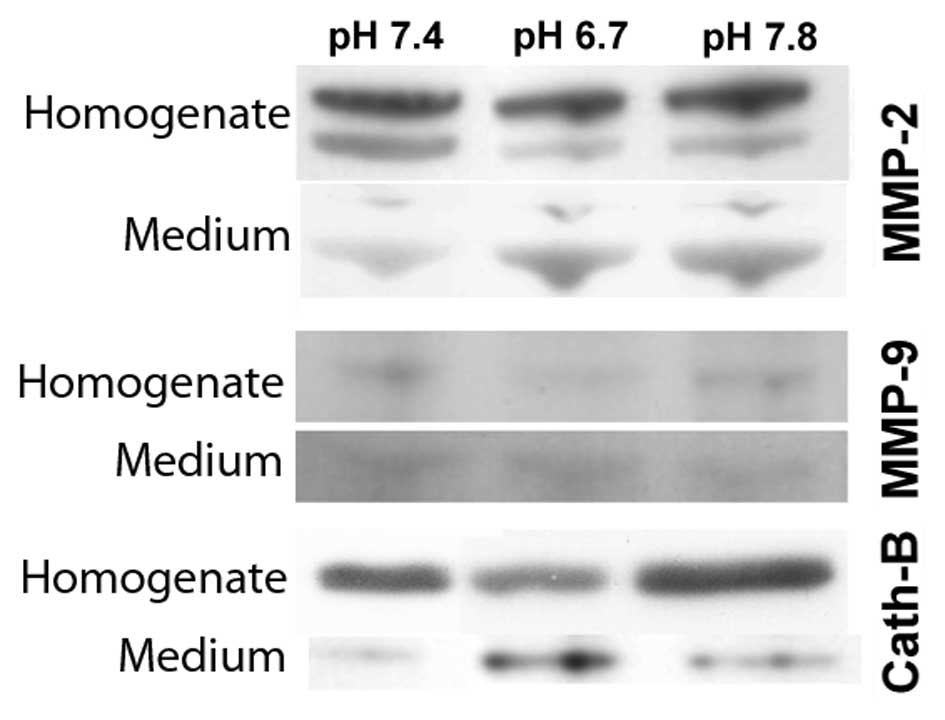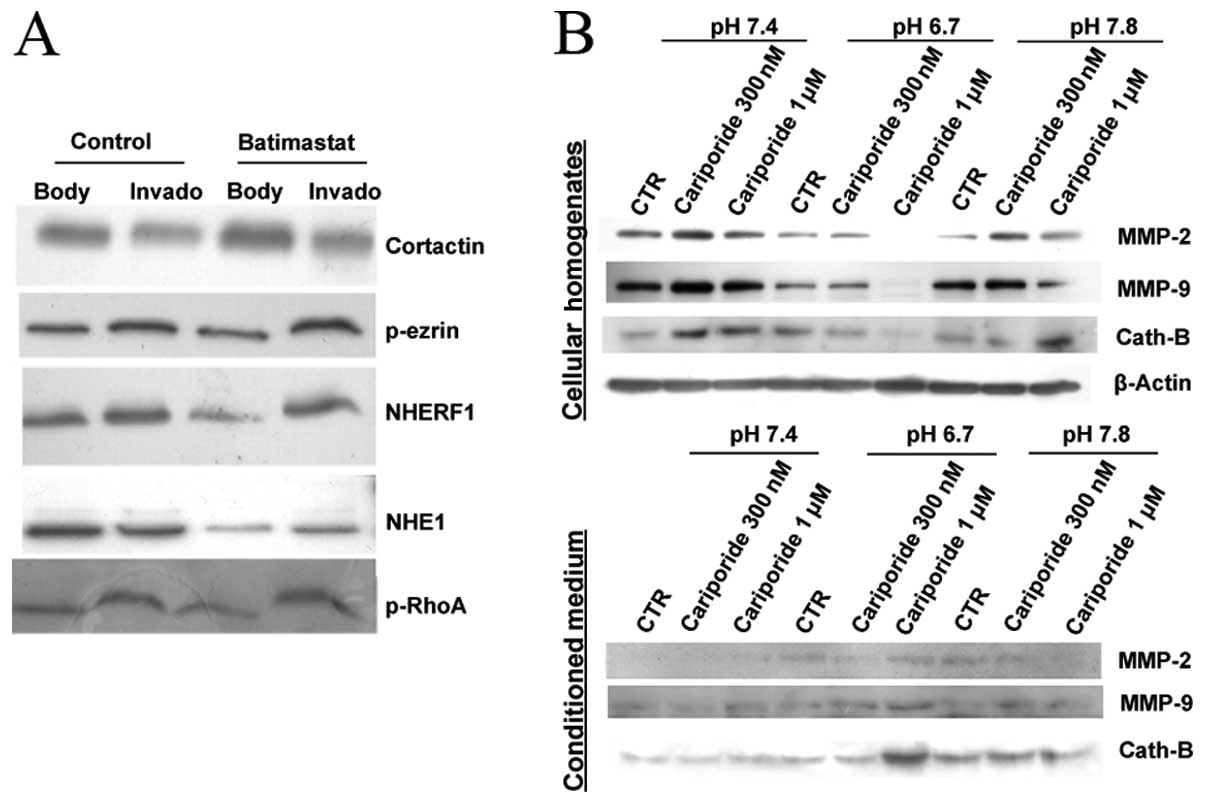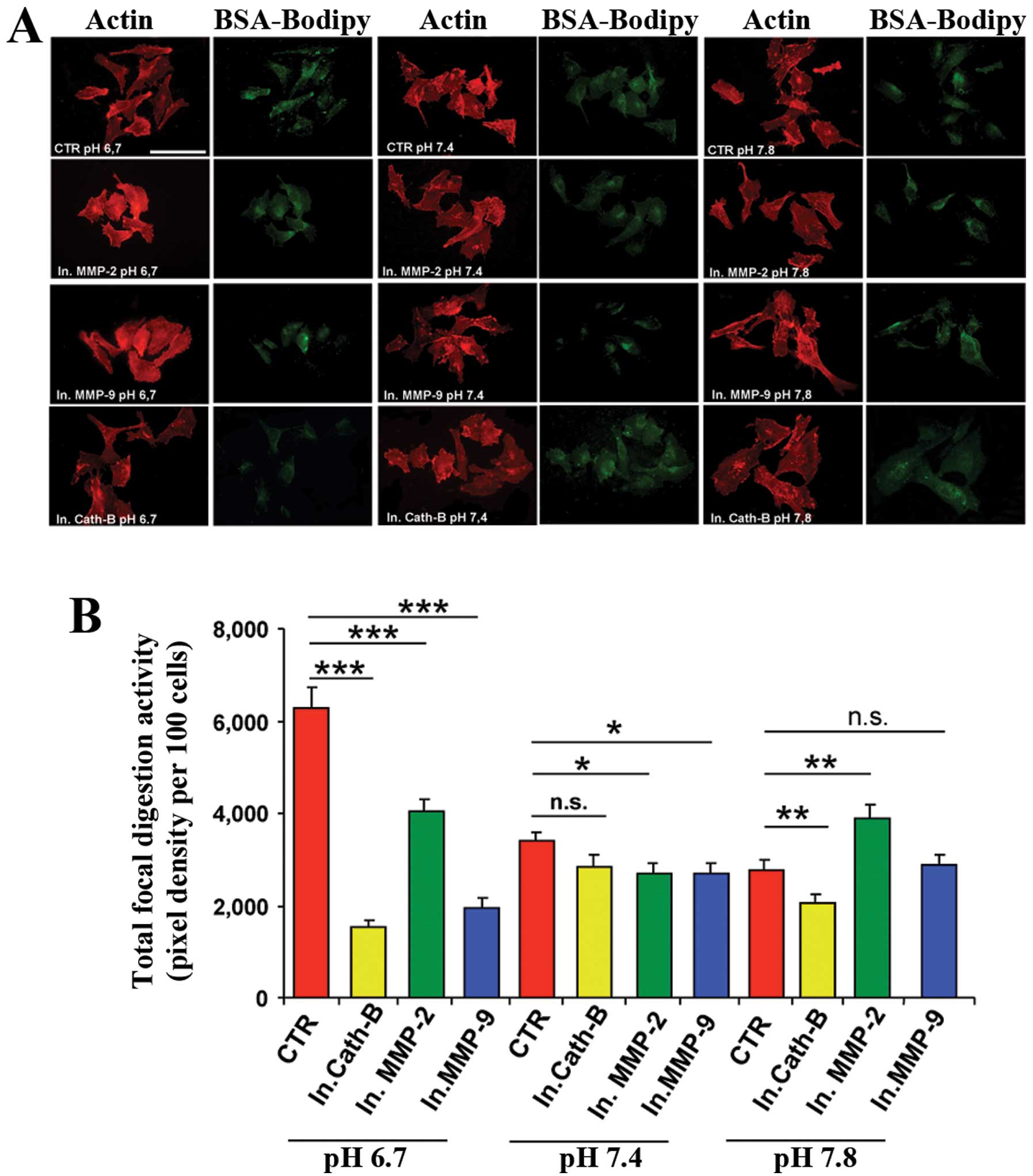|
1
|
Spano D and Zollo M: Tumor
microenvironment: a main actor in the metastasis process. Clin Exp
Metastasis. 29:381–395. 2012. View Article : Google Scholar : PubMed/NCBI
|
|
2
|
Cardone RA, Casavola V and Reshkin SJ: The
role of disturbed pH dynamics and the Na+/H+
exchanger in metastasis. Nat Rev Cancer. 5:786–795. 2005.
View Article : Google Scholar : PubMed/NCBI
|
|
3
|
Bailey KM, Wojtkowiak JW, Hashim AI and
Gillies RJ: Targeting the metabolic microenvironment of tumors. Adv
Pharmacol. 65:63–107. 2012. View Article : Google Scholar
|
|
4
|
Martin NK, Robey IF, Gaffney EA, Gillies
RJ, Gatenby RA and Maini PK: Predicting the safety and efficacy of
buffer therapy to raise tumour pHe: an integrative modelling study.
Br J Cancer. 106:1280–1287. 2012. View Article : Google Scholar : PubMed/NCBI
|
|
5
|
Bourguignon LY, Singleton PA, Diedrich F,
Stern R and Gilad E: CD44 interaction with
Na+-H+ exchanger (NHE1) creates acidic
microenvironments leading to hyaluronidase-2 and cathepsin B
activation and breast tumor cell invasion. J Biol Chem.
279:26991–27007. 2004.PubMed/NCBI
|
|
6
|
Rofstad EK, Mathiesen B, Kindem K and
Galappathi K: Acidic extracellular pH promotes experimental
metastasis of human melanoma cells in athymic nude mice. Cancer
Res. 66:6699–6707. 2006. View Article : Google Scholar : PubMed/NCBI
|
|
7
|
Estrella V, Chen T, Lloyd M, Wojtkowiak J,
Cornnell HH, Ibrahim-Hashim A, et al: Acidity generated by the
tumor microenvironment drives local invasion. Cancer Res.
73:1524–1535. 2013. View Article : Google Scholar : PubMed/NCBI
|
|
8
|
Reshkin SJ, Cardone RA and Harguindey S:
Na+-H+ exchanger, pH regulation and cancer.
Recent Pat Anticancer Drug Discov. 8:85–99. 2013.
|
|
9
|
Mason SD and Joyce JA: Proteolytic
networks in cancer. Trends Cell Biol. 21:228–237. 2011. View Article : Google Scholar : PubMed/NCBI
|
|
10
|
Eckert MA and Yang J: Targeting
invadopodia to block breast cancer metastasis. Oncotarget.
2:562–568. 2011.PubMed/NCBI
|
|
11
|
Yamaguchi H: Pathological roles of
invadopodia in cancer invasion and metastasis. Eur J Cell Biol.
91:902–907. 2012. View Article : Google Scholar : PubMed/NCBI
|
|
12
|
Busco G, Cardone RA, Greco MR, Bellizzi A,
Colella M, Antelmi E, et al: NHE1 promotes invadopodial ECM
proteolysis through acidification of the peri-invadopodial space.
FASEB J. 24:3903–3915. 2010. View Article : Google Scholar : PubMed/NCBI
|
|
13
|
Cardone RA, Greco MR, Capulli M, Weinman
EJ, Busco G, Bellizzi A, et al: NHERF1 acts as a molecular switch
to program metastatic behavior and organotropism via its PDZ
domains. Mol Biol Cell. 23:2028–2040. 2012. View Article : Google Scholar : PubMed/NCBI
|
|
14
|
Cardone RA, Bagorda A, Bellizzi A, Busco
G, Guerra L, Paradiso A, et al: Protein kinase A gating of a
pseudopodial-located RhoA/ROCK/p38/NHE1 signal module regulates
invasion in breast cancer cell lines. Mol Biol Cell. 16:3117–3127.
2005. View Article : Google Scholar : PubMed/NCBI
|
|
15
|
Roomi MW, Monterrey JC, Kalinovsky T, Rath
M and Niedzwiecki A: Distinct patterns of matrix
metalloproteinase-2 and -9 expression in normal human cell lines.
Oncol Rep. 21:821–826. 2009.PubMed/NCBI
|
|
16
|
Matarrese P, Ascione B, Ciarlo L, Vona R,
Leonetti C, Scarsella M, et al: Cathepsin B inhibition interferes
with metastatic potential of human melanoma: an in vitro and in
vivo study. Mol Cancer. 9:2072010. View Article : Google Scholar : PubMed/NCBI
|
|
17
|
Brisson L, Gillet L, Calaghan S, Besson P,
Le Guennec JY, Roger S and Gore J: NaV1.5 enhances
breast cancer cell invasiveness by increasing NHE1-dependent
H+ efflux in caveolae. Oncogene. 30:2070–2076. 2011.
|
|
18
|
Bowden ET, Barth M, Thomas D, Glazer RI
and Mueller SC: An invasion-related complex of cortactin, paxillin
and PKCμ associates with invadopodia at sites of extracellular
matrix degradation. Oncogene. 18:4440–4449. 1999.PubMed/NCBI
|
|
19
|
Caldieri G, Ayala I, Attanasio F and
Buccione R: Cell and molecular biology of invadopodia. Int Rev Cell
Mol Biol. 275:1–34. 2009. View Article : Google Scholar
|
|
20
|
Söderberg O, Gullberg M, Jarvius M,
Ridderstråle K, Leuchowius KJ, Jarvius J, et al: Direct observation
of individual endogenous protein complexes in situ by proximity
ligation. Nat Methods. 3:995–1000. 2006.PubMed/NCBI
|
|
21
|
Lin Y, Chang G, Wang J, Jin W, Wang L, Li
H, et al: NHE1 mediates MDA-MB-231 cells invasion through the
regulation of MT1-MMP. Exp Cell Res. 317:2031–2040. 2011.
View Article : Google Scholar : PubMed/NCBI
|
|
22
|
Putney LK and Barber DL: Expression
profile of genes regulated by activity of the Na-H exchanger NHE1.
BMC Genomics. 5:462004. View Article : Google Scholar : PubMed/NCBI
|
|
23
|
Komarova SV, Pereverzev A, Shum JW, Sims
SM and Dixon SJ: Convergent signaling by acidosis and receptor
activator of NF-κB ligand (RANKL) on the calcium/calcineurin/NFAT
pathway in osteoclasts. Proc Natl Acad Sci USA. 102:2643–2648.
2005.PubMed/NCBI
|
|
24
|
Pereverzev A, Komarova SV, Korcok J,
Armstrong S, Tremblay GB, Dixon SJ and Sims SM: Extracellular
acidification enhances osteoclast survival through an
NFAT-independent, protein kinase C-dependent pathway. Bone.
42:150–161. 2008. View Article : Google Scholar
|
|
25
|
Monet M, Lehen’kyi V, Gackiere F, Firlej
V, Vandenberghe M, Roudbaraki M, et al: Role of cationic channel
TRPV2 in promoting prostate cancer migration and progression to
androgen resistance. Cancer Res. 70:1225–1235. 2010. View Article : Google Scholar : PubMed/NCBI
|
|
26
|
Lucien F, Brochu-Gaudreau K, Arsenault D,
Harper K and Dubois CM: Hypoxia-induced invadopodia formation
involves activation of NHE-1 by the p90 ribosomal S6 kinase
(p90RSK). PLoS One. 6:e288512011. View Article : Google Scholar : PubMed/NCBI
|
|
27
|
Magalhaes MA, Larson DR, Mader CC,
Bravo-Cordero JJ, Gil-Henn H, Oser M, et al: Cortactin
phosphorylation regulates cell invasion through a pH-dependent
pathway. J Cell Biol. 195:903–920. 2011. View Article : Google Scholar : PubMed/NCBI
|
|
28
|
Fredriksson S, Gullberg M, Jarvius J,
Olsson C, Pietras K, Gústafsdóttir SM, et al: Protein detection
using proximity-dependent DNA ligation assays. Nat Biotechnol.
20:473–477. 2002. View Article : Google Scholar : PubMed/NCBI
|


















